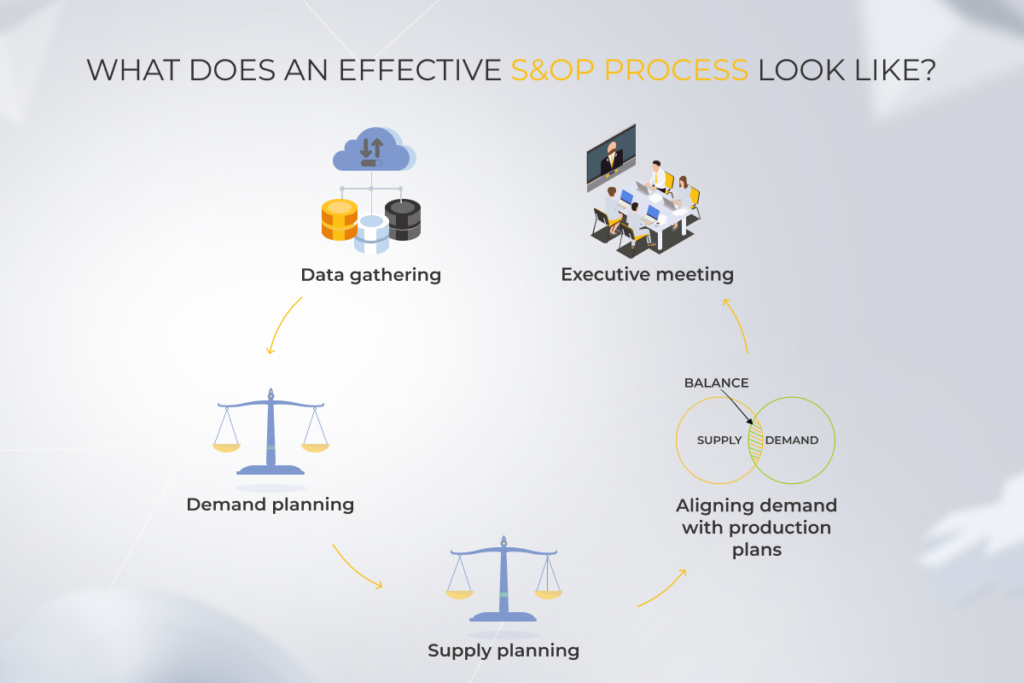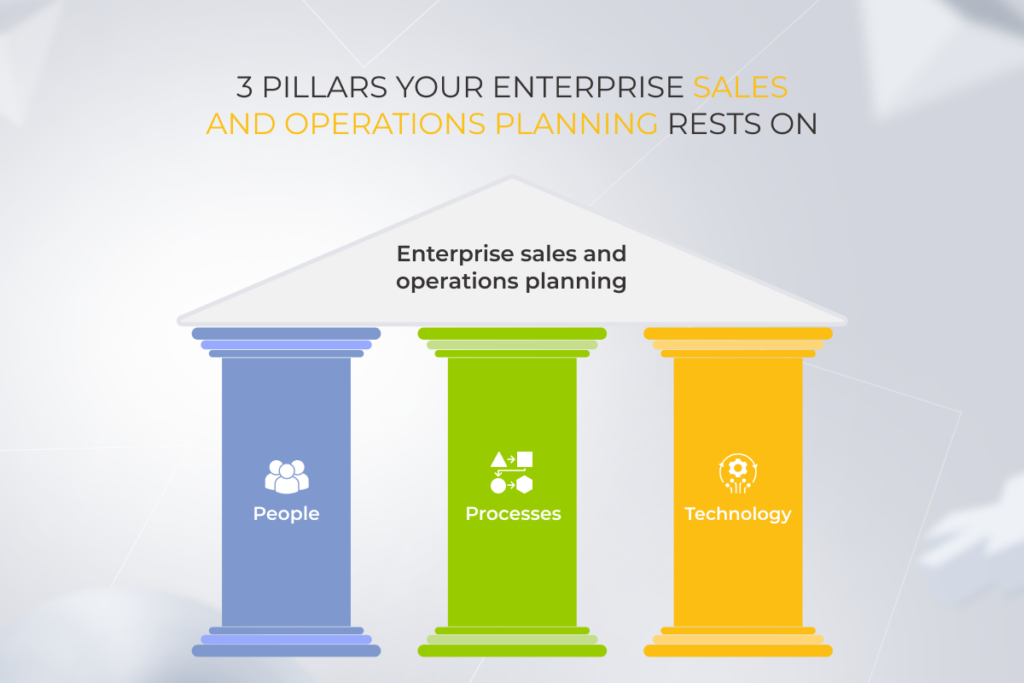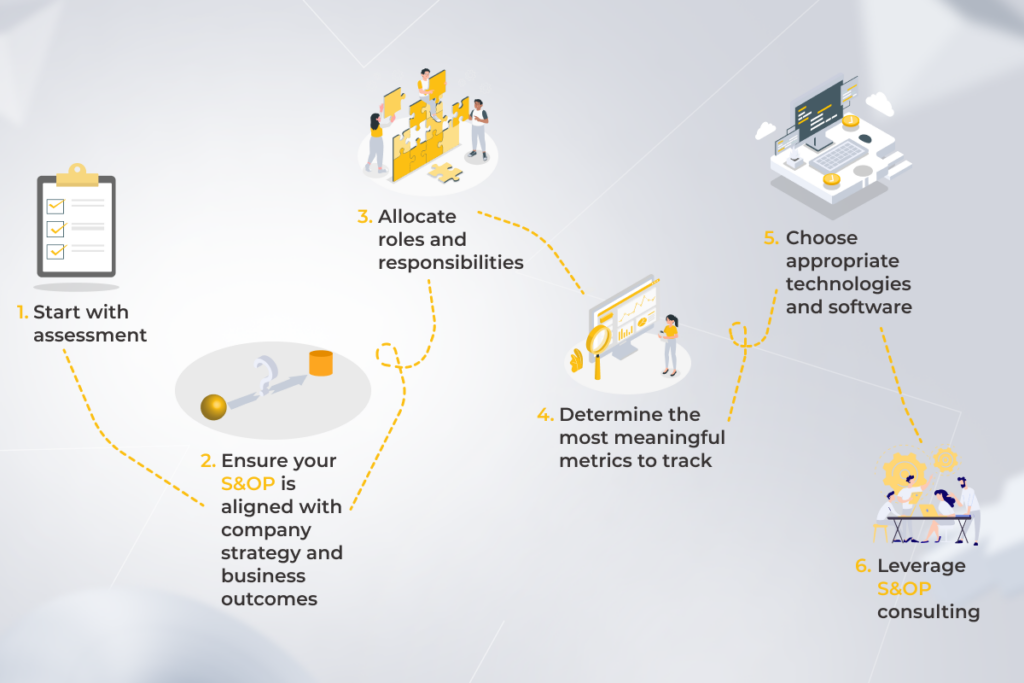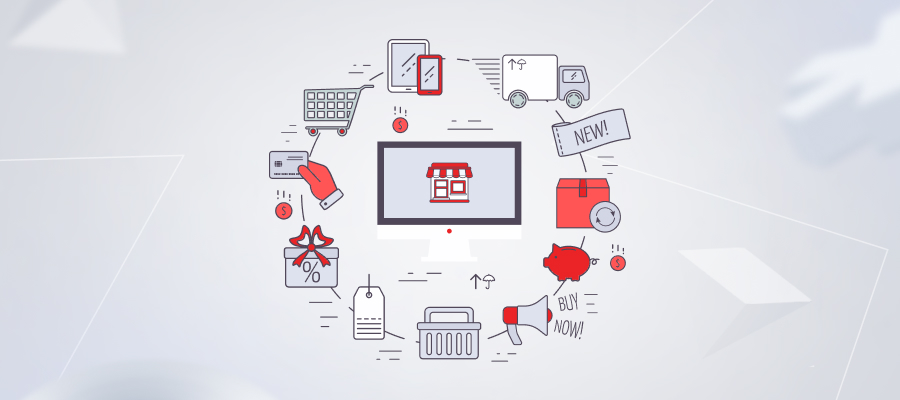Contents
- What does an effective S&OP process look like?
- What stands in the way of solid S&OP? The main challenges to address
- 3 pillars your enterprise sales and operations planning rests on
- 1. Start with assessment
- 2. Ensure your S&OP is aligned with company strategy and business outcomes
- 3. Allocate roles and responsibilities
- 4. Determine the most meaningful metrics to track
- 5. Choose appropriate technologies and software
- 6. Leverage S&OP consulting
- Build resilience in times of upheaval with well-thought-out S&OP
‘How to implement the S&OP process?’ should be one of the most critical questions that companies ask. Here’s why.
Managing supply and demand is a notorious hurdle for many businesses, which requires finance, sales, and operations to work in close cooperation. In today’s uncertain political and economic climate, the synchronization of supply and demand has gained even more importance.
Sales and operations planning enables companies to improve their visibility into short-term and long-term demand as well as supply trends while proactively managing the potential challenges that come with unpredictable events. Through S&OP, businesses can develop strategies to ensure they are prepared for any possible disruptions in the supply chain or unexpected changes in customer demands.
In this article, we will discuss what effective S&OP looks like, how to implement S&OP process, outline common adoption challenges and solutions, and discuss the benefits of sales and operations planning.
What does an effective S&OP process look like?

An effective S&OP is critical to success in any business. It helps organizations coordinate, plan, and optimize their operations across all departments to align demand with production and manage costs and inventory levels.
Here is what an effective S&OP process consists of:
Data gathering
It would be great to have all the data you need in one place, right? For instance, information from internal and external sources, such as customer orders, market trends, sales forecasts, and production plans. But unfortunately, it does not work like that. In 99% of companies, analysts should consolidate this data from many sources into a single analytics platform to ensure accuracy and uniformity.
Demand planning
With the data gathered, businesses can create accurate demand forecasts to better understand customer needs and expectations, which will allow them to anticipate how much inventory they should have on hand at any given time.
Supply planning
Businesses need to plan for the raw materials, production capacity, and labor required for each order or product line to meet customer demand. This will help the organization anticipate any potential supply issues and find solutions to prevent disruptions.
Aligning demand with production plans
An S&OP specialist must take into account capacity constraints, production lead times, and resource availability when creating a plan of action for each order or product line, ensuring that customer demand is aligned with production goals.
Executive meeting
This critical stage brings together decision-makers from across all the departments to review the data gathered, forecasts generated, and plans created during the enterprise sales and operations planning process. Thus, they can assess whether current plans are on track to meet customer needs while adhering to budget and resource constraints.
What stands in the way of solid S&OP? The main challenges to address
The implementation of S&OP is a complex process that can be hampered by various challenges that organizations may encounter along the way. In this section, we will explore some of the common issues associated with S&OP implementation.
Inadequate strategizing
A poor strategy is one of the most recurring problems in sales and operations planning. Without a thorough understanding of the current capabilities and the capacity to expand, businesses will hardly come up with feasible plans that will meet customer demands. Additionally, organizations have to consider factors such as labor availability, budget constraints, supply chain disruptions, and seasonality when strategizing for an S&OP process map.
Lack of understanding and support from the stakeholders
Lack of support from the primary stakeholders is another common issue faced in S&OP implementation. Businesses must ensure that all decision-makers are on board with the process and understand its importance for success. Most importantly, organizations should leverage data visualization to help stakeholders better understand the implications of their decisions.
Insufficient visibility and transparency across departments
S&OP success heavily depends on communication and collaboration between departments. Without visibility into all the departments’ operations, businesses cannot create plans that align with their overall objectives. That is why it’s paramount to facilitate cross-department operation visibility by maintaining up-to-date data and granting the necessary level of access to appropriate digital systems for everyone involved in the process.
Complicated process design
Paradoxically, complicated process design often arises from our inherited desire to optimize operations and make them more efficient. Accounting for all the exceptions and nuances in the S&OP process often leads to more complications than efficiencies. Rather than attempting to make an overly complex system that covers all possible scenarios, prioritize what is essential for success and build on that foundation. Any non-essential requirements can be built upon over time as the process matures. When designing S&OP, make simplicity a priority.
Lack of technologies that support the process
To maximize the potential of S&OP, businesses must have access to the software that can facilitate data gathering and analysis, such as enterprise resource planning (ERP) or supply chain management (SCM) systems. Without these tools, businesses lack the ability to accurately assess customer demand and plan for resources.
Ready to reap the benefits of S&OP?
3 pillars your enterprise sales and operations planning rests on

In a way, the end goal of establishing a solid S&OP process is not about finding the perfect balance between sales and operations but ensuring that people, technologies, and processes are so in tune with each other that sales and operations align naturally.
- People
Successful S&OP leans on stakeholder buy-in, cross-functional engagement, and continuous negotiation. Getting support from key decision-makers is vital to creating a unified process with everyone on the same page. A fully invested chief demand officer, along with other members of the C-suite, need to step to the forefront and clearly communicate vision and a sense of urgency to all relevant staff.
- Processes
In a nutshell, processes need to be driven by data. Process design should stem from quantifiable and measurable information rather than be based on a generic template. Value-adding S&OP is about coming up with multiple scenarios and strategizing for each of them. Again, making multiple long-term decisions in advance is possible when the right people have seamless access to advanced analytics tools.
- Technology
Ensuring that your software systems are correctly configured and seamlessly integrated is as important as defining roles and establishing operations. Successful S&OP hinges on access to real-time operational data presented in an easily-digestible format within one platform. The right technology infrastructure is also a key enabler for fruitful collaboration, as everyone makes decisions based on the same set of inputs.
6 STEPS ON HOW TO IMPLEMENT AN S&OP PROCESS
Now that we have discussed the challenges and identified the three pillars of successful enterprise sales and operations planning, it’s time to dive into the details of creating an S&OP roadmap. Here’s your step-by-step guide on how to implement an S&OP process that yields tangible results.

1. Start with assessment
Universal to many other technology and process implementations, it’s essential to create a common understanding of the ‘as-is’ situation in the beginning. The current state of your processes should be defined both qualitatively and quantitatively. Qualitative assessments involve evaluating the existing processes and structure within your organization, while quantitative assessments require measuring the performance of existing activities. It’s as important to define product hierarchy as it is to survey key decision-makers and identify their pain points.
2. Ensure your S&OP is aligned with company strategy and business outcomes
Once the current state is properly evaluated, it’s important to tie S&OP processes to company objectives. This should include customer service goals, supplier and partner relationships, pricing objectives, and production/manufacturing capabilities. Forming synapses between sales, operations, and finance teams is instrumental to making sure that everyone is working toward the same goals.
3. Allocate roles and responsibilities
Too many organizations struggle to unlock S&OP’s potential because there is no clear understanding of who does what. Each party needs to be aware of the role they play in S&OP and can regularly communicate their insights. Having well-defined roles and responsibilities helps establish ownership and accountability of the S&OP process. This can be further enhanced by establishing regular reporting cycles and outlines on how to best utilize data sources.
4. Determine the most meaningful metrics to track
Next, you should make S&OP performance measurable by defining the most meaningful metrics. These metrics should be defined based on the overall business objectives; for example, if customer service is a priority, then inventory levels and order fill rate are likely to be tracked more closely than production costs. Here are some other examples of important S&OP metrics:
Forecast accuracy
The accuracy of your demand and production cycles is one of the most important metrics to consider, as it communicates the success of your planning efforts.
On-time delivery (OTD) to the customer
OTD is defined by the ratio of products delivered on time to total deliveries made over a specific period. OTD indicates the efficiency of your supply chain and is closely correlated with overall customer satisfaction.
Production plan adherence
The adherence to the production plan reflects how closely the production output follows the planned production. This metric can help expose production bottlenecks, tighten delivery windows, and determine how well the machinery is performing.
5. Choose appropriate technologies and software
According to an APQC survey, almost 70% of S&OP professionals consider technology to be a mission-critical part of the success of S&OP initiatives. Choosing the right technologies and software is vital for gathering and analyzing pertinent information and reaping the most benefits of sales and operations planning.
Cloud computing
Having cloud capabilities in place allows organizations to easily collect, store and analyze the data necessary for effective S&OP decision-making. Cloud computing also offers scalability advantages over traditional on-premises solutions, making it easy for companies to expand their storage needs or quickly adjust capacity as business conditions change.
Business Intelligence
In general, business intelligence is the most critical component of S&OP. It enables organizations to track KPIs, access important data at the right time, improve prediction accuracy, model scenarios, and improve visibility into your processes overall. With comprehensive data visualization solutions, BI becomes more accessible and further facilitates data-driven decision-making.
Artificial intelligence and machine learning
The combination of AI and S&OP can significantly improve prediction accuracy and help organizations consider market trends, consumer patterns, and external factors when making decisions. Additionally, AI can be used to automate administrative processes such as sales order approval, enabling S&OP teams to focus on more important tasks.
IoT
Incorporating the IoT into S&OP can give companies an unprecedented level of detail and visibility into their operations. With IoT, companies can remotely monitor inventory levels across multiple locations, track delivery, and proactively plan for future demand. In most cases, adopting IoT usually calls for unique technological infrastructure, which is why many organizations opt for custom enterprise application development. This allows businesses to integrate IoT with other technologies into a single system.
ERP and SCM
ERP and SCM systems are fundamental to enterprise sales and operations planning, as they ensure a comprehensive view of the entire supply chain process. ERP solutions enable organizations to track demand and optimize inventory management, manage customer orders and deliveries, integrate logistics operations, and monitor transportation costs. SCM systems provide organizations with important information about order-to-cash cycle times, product lead times, and delivery performance. Essentially, ERP and SCM gather crucial demand and supply data that is essential to S&OP success.
6. Leverage S&OP consulting
Filled with many intricacies, S&OP implementation should not be taken lightly. Quite the contrary, it’s an integral component of technology-enabled business transformation that enables organizations to gain economies of scale, drive efficiency, and increase customer satisfaction. To guarantee the success of the initiative, it is critical to work with a reliable S&OP consulting and technology partner who will guide you every step along the way.
Build resilience in times of upheaval with well-thought-out S&OP
Having an effective S&OP process in place helps organizations to gain better visibility into their supply chain, reduce costs, and make decisions that are informed by data rather than based on simple hunches. With the right strategies and technologies for managing uncertainty due to external factors, such as pandemics or shifting regulations, businesses will be able to remain agile and resilient in the face of change.
Ultimately, a well-planned S&OP process contributes to an organization’s overall success. To achieve maximum benefits from S&OP initiatives, companies must address all the key components outlined above and implement appropriate technology solutions that enable efficient decision-making across all levels of the organization.
It’s time to reinvent your sales and operations processes










